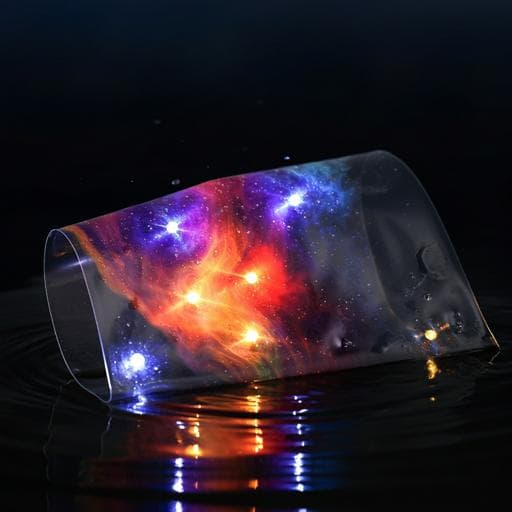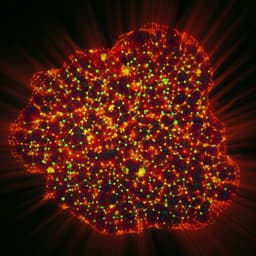
Engineering and Technology
Quantum dot lasing from a waterproof and stretchable polymer film
M. Mohammadimasoudi, P. Geiregat, et al.
This groundbreaking research showcases a flexible, free-standing film laser made from a thin film of quantum dots embedded in polymerized chiral liquid crystal, offering stable, narrow-linewidth lasing under water at room temperature. Conducted by Mohammad Mohammadimasoudi and his team, this technology promises exciting applications as a sensitive sensor.
~3 min • Beginner • English
Introduction
The study addresses the challenge of integrating colloidal semiconductor quantum dots (QDs) as optical gain media into laser cavities that fully exploit their high material gain, strong pump absorption, photostability, and compatibility with solution processing. While QD lasers have progressed from femtosecond-pumped devices to quasi-continuous-wave operation and first steps toward electrical pumping, most flexible implementations rely on distributed feedback (DFB) structures with limitations such as dependence on environmental index contrast, pump spot size, and asymmetric beam profiles. Chiral nematic (cholesteric) liquid crystals (CLCs) provide self-assembled, tunable photonic band gap mirrors and, when polymerized, yield robust solid-state reflectors. The purpose is to realize a free-standing, flexible, waterproof vertical-cavity surface-emitting laser (VCSEL) by embedding a thin QD gain layer between two polymerized CLC mirrors, enabling circularly polarized defect-mode lasing with narrow linewidth and to investigate how external stimuli (pressure, strain, temperature) tune the lasing wavelength.
Literature Review
Prior work has established QDs as promising gain media for optically pumped lasers, with devices evolving from femtosecond-pumped to quasi-CW operation and early efforts toward electrical pumping. A wide range of cavity designs have been used (droplets, spheres, disc resonators, DFB structures), reflecting the versatility enabled by high material gain (>1000 cm⁻¹) and solution processability (drop-casting, spin-coating). Flexible QD lasers reported to date are mainly DFB-type on polymer gratings, where feedback and lasing depend strongly on environmental refractive index and pump spot size, often yielding asymmetric beams. Liquid crystals offer electrical and optical tunability; chiral nematic LCs (CLCs) form helical structures with a one-dimensional photonic band gap that selectively reflects one circular polarization. Reactive LC mixtures can be polymerized to lock in optical structures, enabling cholesteric LC lasers and cholesteric polymer lasers with dyes and with semiconductor QDs. However, achieving robust, large-domain polymer CLC mirrors and integrating them with QD gain layers in flexible, durable, index-agnostic cavities remains a need.
Methodology
- QD synthesis and characterization: CdSe core QDs (wurtzite, ~3.8 nm diameter) were synthesized and overcoated with CdS to form CdSe/CdS core/shell QDs (~7.4 nm average diameter). Absorption and photoluminescence were measured in toluene (emission centered ~640 nm). Transient absorption spectroscopy following 530 nm photoexcitation quantified gain: a broadband probe measured absorbance; negative values indicated net gain. Spectral intrinsic absorption coefficient μ was extracted 3 ps after excitation. Accounting for local field factor provided material gain. Gain dynamics at 630 nm were tracked, showing net gain persisting for several hundred ps.
- CLC mirror fabrication: Solid CLC layers were produced by photopolymerizing a liquid crystalline acrylate mixture doped with a chiral agent to set the pitch (PBG width Δλ = Δn·p). An adapted method yielded large-domain (~10 mm²) polymer CLC mirrors stable up to 100 °C. Two such mirrors were fabricated on separate substrates.
- Laser cavity assembly: Between the two polymerized CLC mirrors, a three-layer isotropic stack was formed: poly(vinyl alcohol) (PVA, 280 nm), QD film (100 nm), and glue (940 nm). The complete stack was initially assembled between glass substrates with alignment layers and ITO as per the schematic. The resulting reflector spectrum showed a PBG spanning ~600–660 nm, overlapping the QD PL.
- Optical pumping and spectroscopy: The device was pumped at 532 nm with nanosecond pulses; pump beam diameter ~200 μm. Emission spectra were recorded below and above threshold with low- and high-resolution setups (high-resolution spectral resolution ~0.03 nm). Far-field emission patterns were measured to assess spatial coherence and angular dependence. Circular polarization was verified with a quarter-wave plate (45°) and a rotating linear polarizer.
- Electromagnetic simulations: Emission spectra in the normal direction were simulated using the measured QD emission spectrum and implementing optical gain by adding an imaginary component to the QD layer refractive index (varied at 630 nm from 0 to 0.0466). Defect and band-edge modes were analyzed; interface reflection losses were considered.
- Free-standing film preparation and durability testing: The glass substrates were detached to obtain a free-standing film (~15 μm total thickness). Long-term stability was tested by recording lasing spectra continuously for 9 h at 1 kHz (8 mJ·cm⁻² pump), totaling >32 million pulses, and by shelf storage for one year.
- External stimulus tests: Pressure-induced tuning was evaluated by applying mechanical pressure with clamps on the film between glass plates; corresponding simulations modeled uniform thickness reduction (strain ε ≈ −2.2×10⁻⁴, total thickness reduction ~3.3 nm). Waterproof operation was assessed by immersing the free-standing film in water and recording emission and threshold. Temperature tuning was performed by heating/cooling the water bath and monitoring lasing wavelength shifts; measurements were limited at high temperatures by bubble formation on the beaker surface. Spatial variability due to CLC domain pitch variations was documented by imaging and by measuring lasing spectra at multiple locations; simulations with different CLC pitches were compared.
Key Findings
- QD gain: Transient absorption showed a transition from net absorption to net stimulated emission with increasing excitation. Maximum intrinsic gain near 630 nm was ~1500 cm⁻¹; including local field factor, material gain ~3600 cm⁻¹. Net gain persisted for several hundred picoseconds at 630 nm.
- Cavity and lasing: The CLC mirror PBG spanned ~600–660 nm, overlapping the QD emission. A defect mode within the band gap enabled lasing near 630–632 nm. Simulations matched measurements, also revealing band-edge modes (~585 nm and ~655 nm). Lasing threshold was ~7 mJ·cm⁻² (pump at 532 nm, ~200 μm spot). Spectral linewidth collapsed at threshold to ~0.08 nm (80 pm), close to the measurement limit and narrower than prior reports. Far-field measurements showed symmetric, narrowly directed emission. Polarization analysis confirmed circular polarization, as expected for a defect-mode CLC laser.
- Flexibility and durability: Free-standing films (~15 μm) operated stably for at least 9 hours continuous pulsed pumping at 1 kHz (8 mJ·cm⁻²), totaling >3.2×10⁷ pulses, with consistent linewidth behavior. Devices remained operational after one year of shelf storage.
- Environmental robustness: The laser operated under water with essentially unchanged spectrum and threshold; operation in other polar protic solvents (formic acid, isopropanol, ethanol, water) is supported by the encapsulation, as noted in the abstract.
- Stimuli-responsive tuning: Applying pressure induced a continuous blue shift of the lasing wavelength; simulations reproduced this via a small compressive strain (ε ≈ −2.2×10⁻⁴) corresponding to ~3.3 nm total stack thickness reduction. Temperature tuning in water produced a reversible red shift with heating and blue shift with cooling, with a slope of ~0.5 nm/°C across multiple samples/locations. The lasing wavelength was insensitive to the optical properties of the surrounding medium.
- CLC domain effects: Spatial variability in CLC pitch and thickness across domains led to location-dependent lasing wavelengths; measured spectra at multiple points matched simulations using different CLC pitches.
Discussion
Embedding a high-gain CdSe/CdS QD film between polymerized CLC mirrors yields a vertical cavity that capitalizes on the QDs’ strong gain and the CLC’s self-assembled, high-reflectivity circular Bragg mirrors. The defect-mode resonance within the PBG enables low-threshold, narrow-linewidth, circularly polarized lasing with symmetric far-field emission, overcoming limitations of DFB-based flexible QD lasers (environmental index sensitivity, beam asymmetry). The polymerized CLC encapsulation and isotropic interlayers provide mechanical integrity and environmental sealing, conferring waterproof operation and long-term stability under intense pulsed excitation. The cavity’s lasing wavelength is predictably tunable by mechanical strain/pressure and temperature, while remaining largely unaffected by the external refractive index—features valuable for sensing applications. The demonstrated performance (threshold ~7 mJ·cm⁻², ~80 pm linewidth, >3.2×10⁷ pulse lifetime) indicates that the combination of solution-processable inorganic QDs with robust CLC polymer mirrors can deliver practical, flexible VCSEL-like devices suitable for operation in aqueous and protic environments. The observed linear thermal tuning (~0.5 nm/°C) and pressure-induced blue shift provide straightforward transduction mechanisms for temperature, strain, or pressure sensing.
Conclusion
This work demonstrates a free-standing, flexible, and waterproof vertical-cavity laser based on a 100 nm CdSe/CdS QD gain layer sandwiched between two polymerized chiral liquid crystal mirrors. The device exhibits forward-directed, circularly polarized defect-mode lasing within the CLC photonic band gap, with a low threshold (~7 mJ·cm⁻²), narrow linewidth (~0.08 nm), symmetric far-field emission, and long operational stability (>3.2×10⁷ pulses; operational after one year of storage). The lasing wavelength is tunable via applied pressure/strain and temperature (~0.5 nm/°C), while being robust to immersion in water and other protic solvents, highlighting its potential as a flexible optical sensor platform in aqueous or biological environments. Future work could refine cavity uniformity across large areas, extend wavelength coverage via pitch and QD emission tuning, quantify and calibrate strain/pressure responsivity, and explore pathways toward lower-threshold pumping and eventual electrical excitation.
Limitations
- The measured spectral linewidth (~0.08 nm) is close to the instrument resolution limit, potentially overestimating the true linewidth.
- Temperature-dependent measurements in water were limited at higher temperatures by bubble formation on the beaker surface, which disturbed data acquisition.
- Variations in CLC domain pitch and thickness lead to spatial nonuniformity in lasing wavelength across the film.
- Reported devices are optically pumped; electrical pumping was not demonstrated in this study.
Related Publications
Explore these studies to deepen your understanding of the subject.







